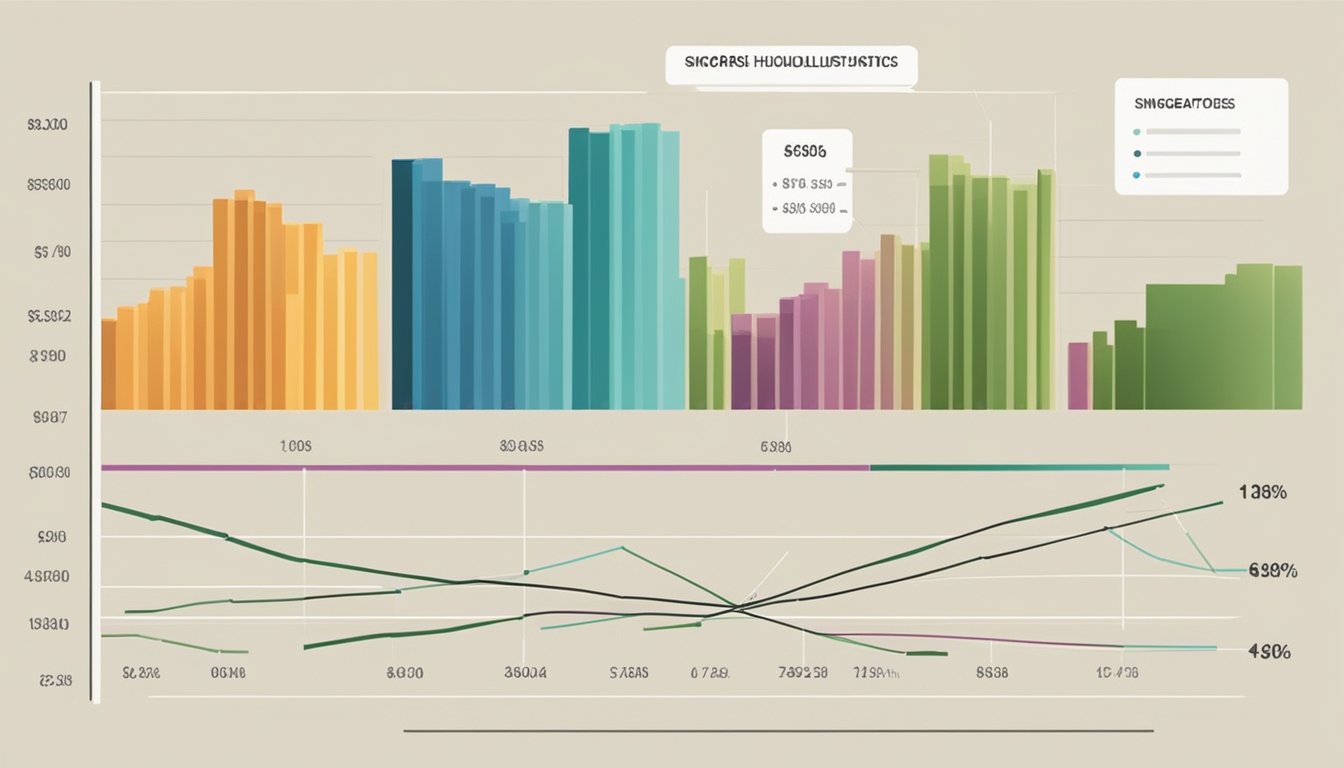If you’re a resident of Singapore, you may be interested in understanding more about gross household monthly income. This is an important metric that can help you determine your eligibility for various government schemes and programmes. In this article, we’ll explore what gross household monthly income is, how it’s calculated, and why it matters.

Understanding gross household monthly income is crucial for many reasons. For one, it’s a key factor in determining your eligibility for government schemes like the Community Health Assist Scheme (CHAS). Additionally, it can help you get a better sense of your overall financial health and how you compare to other households in Singapore. By understanding your gross household monthly income, you can make more informed decisions about your finances and plan for the future.
In this article, we’ll go over some of the key demographic and economic factors that can impact gross household monthly income in Singapore. We’ll also take a closer look at the statistical overview of household income in Singapore, including average income levels and income distribution. Finally, we’ll explore some of the ways that the government contributes to household income through various programmes and discuss how taxation and housing costs can impact your gross household monthly income.
Key Takeaways
- Gross household monthly income is an important metric for determining eligibility for government schemes and programmes in Singapore.
- Demographic and economic factors can impact gross household monthly income, and it’s important to understand how these factors can affect your finances.
- Understanding your gross household monthly income can help you make more informed decisions about your finances and plan for the future.
Understanding Gross Household Monthly Income

If you are a resident of Singapore, you may have heard the term “gross household monthly income” being used quite often. It is an important concept to understand, as it determines your family’s financial well-being. In this section, we will take a closer look at what gross household monthly income is, its components, and the sources of income for Singapore households.
Components of Household Income
Your gross household monthly income is the total amount of money your household earns from all sources of income. This includes your basic employment income, trade/self-employed income, overtime pay, allowances, cash awards, commissions, bonuses, tips, and other allowances. One-twelfth of your annual bonuses is also included in your gross household monthly income.
Income Sources for Singapore Households
Singapore households earn their income from various sources, including employment, self-employment, and investments. The majority of households in Singapore earn their income from employment. This includes full-time and part-time jobs, as well as temporary and contract work.
Self-employment is another source of income for Singapore households. This includes running a business, freelancing, or working as a sole proprietor. Self-employed individuals are responsible for their own income tax and CPF contributions.
Investments, such as stocks, bonds, and mutual funds, can also generate income for households. However, this source of income is not as common as employment and self-employment.
In conclusion, understanding your gross household monthly income is crucial for managing your family’s finances. It is made up of various components, including wages, salaries, overtime pay, allowances, commissions, bonuses, and one-twelfth of your annual bonuses. Singapore households earn their income from various sources, including employment, self-employment, and investments.
Demographic and Economic Factors

Influence of Age and Household Size
The age and size of your household can significantly impact your gross monthly income. According to the Singapore Department of Statistics, the average household size decreased over the past 10 years. In 2020, the proportion of single-person households increased to 16.0% from 12.2% in 2010. Additionally, the proportion of resident households with at least one member aged 65 years and above also increased to 34.5% in 2020 from 24.1% in 2010.
As you age, your income level may increase as you gain more experience and skills in your profession. However, if you are retired or approaching retirement age, your income may decrease due to a decrease in work hours or retirement benefits.
Impact of Industry and Profession on Income
Your industry and profession also play a crucial role in determining your gross monthly income. Different industries and professions have different income levels and growth rates, and some may require more education or training than others.
For example, according to data from the Singapore Department of Statistics, the median monthly income from work (including employer CPF contributions) among resident and resident employed households in 2023 was $13,958. However, the average monthly household income per household member varied by deciles, with the 41st to 50th deciles earning $5,051, while the 1st to 10th deciles earned $706.
Professions such as doctors, lawyers, and engineers generally have higher income levels than those in administrative or service-related positions. Additionally, those with higher levels of education tend to earn more than those with lower levels of education.
In conclusion, your gross monthly income is influenced by various demographic and economic factors. Your age, household size, industry, profession, and education level are all important factors to consider when determining your income level.
Statistical Overview of Household Income

When it comes to understanding the income distribution in Singapore, the Singapore Department of Statistics is the go-to source. The figures provided by the department give a clear picture of the income trends and growth, median income, and income inequality measures in the country.
Income Trends and Growth
According to the latest data from the department, the median monthly household income from work among resident employed households in 2023 was $3,500. This represents a 3.1% increase cumulatively or 0.6% per annum in real terms from 2018 to 2023.
Moreover, the department’s data shows that the average monthly household income from work was $13,958 in 2023. However, it is important to note that this figure is for household income and not for an individual’s income.
Median Income and Inequality Measures
The median income is a useful measure of income distribution as it represents the income level that separates the top half of the population from the bottom half. In Singapore, the median monthly household income from work per household member rose from $3,287 in 2022 to $3,500 in 2023, an increase of 6.5% in real terms.
Income inequality in Singapore is also an important issue to consider. The Gini coefficient, which measures income inequality on a scale of 0 to 1, was 0.458 in 2023. This indicates that income inequality in Singapore is still relatively high, although it has been gradually decreasing in recent years.
In summary, the statistical overview of household income in Singapore shows that there has been a steady growth in income over the years. However, income inequality remains a concern, and efforts need to be made to address this issue.
Government Contributions and Taxation

When it comes to gross monthly household income in Singapore, it’s important to consider the role of government contributions and taxation. Here, we’ll explore two key factors that can impact your take-home pay: CPF contributions by employers and personal income tax considerations.
CPF Contributions by Employers
As an employee in Singapore, your employer is required to contribute to your Central Provident Fund (CPF) account. This is a type of social security savings plan that provides for retirement, healthcare, and home ownership needs. The CPF contribution rate for employers is currently set at 17% of your gross monthly salary, up to a certain cap.
It’s worth noting that CPF contributions are not considered part of your gross monthly income. Instead, they are deducted from your salary before it is paid out to you. This means that your take-home pay will be lower than your gross monthly income, but you’ll also be building up savings for your future needs.
Personal Income Tax Considerations
In addition to CPF contributions, you’ll also need to consider personal income tax when calculating your net income. Singapore has a progressive income tax system, which means that the more you earn, the higher your tax rate will be.
For the year 2024, the tax rates range from 0% to 22%, depending on your income level. However, it’s worth noting that there are various deductions and reliefs available that can help to reduce your tax bill. For example, you may be able to claim deductions for expenses related to your employment, such as professional development courses or work-related travel.
It’s also important to note that the Singapore government has made efforts to make the tax system more business-friendly in recent years. For example, there are various tax incentives available to encourage businesses to invest in research and development, or to set up operations in certain areas.
Overall, understanding the role of government contributions and taxation is key when it comes to calculating your net income in Singapore. By taking these factors into account, you can get a clearer picture of your take-home pay and plan accordingly for your future needs.
Housing and Living Standards

As a Singapore citizen, your gross household monthly income plays a significant role in determining your standard of living. Housing is one of the most important factors that affect your quality of life. Your income determines the type of dwelling you can afford, and the cost of living in that dwelling.
Income by Dwelling Type
According to the Household Expenditure Survey, the average monthly household expenditure for HDB 1- and 2-room flats is around $1,300, while the average monthly household expenditure for HDB 3-room flats is around $1,800. The average monthly household expenditure for HDB 4-room flats is around $2,200, and for HDB 5-room flats, it is around $2,600. The average monthly household expenditure for private apartments and condominiums is much higher, at around $4,000.
However, the cost of living in HDB flats is lower than in private apartments and condominiums. HDB flats are also eligible for government subsidies, such as the Community Health Assist Scheme (CHAS), which provides medical and dental subsidies to lower-income households.
Household Expenditure and Income
The total household income determines the household’s ability to afford basic necessities such as food, clothing, and shelter. According to the Department of Statistics, the median monthly household income from work among resident employed households in Singapore was $9,189 in 2020, reflecting the impact of the COVID-19 pandemic. The median monthly household income from work for the past 10 years increased in real terms.
The Household Expenditure Survey shows that the average monthly household expenditure in Singapore was around $4,500 in 2020. The largest expenditure category was housing, which accounted for around 23% of total household expenditure. Other significant expenditure categories include transport, food, and education.
In conclusion, your gross household monthly income in Singapore plays a crucial role in determining your standard of living. Housing is a significant factor in your cost of living, and your income determines the type of dwelling you can afford. The cost of living in HDB flats is lower than in private apartments and condominiums, and HDB flats are eligible for government subsidies. The total household income determines the household’s ability to afford basic necessities, and housing is the largest expenditure category for most households.
Frequently Asked Questions

What’s the average monthly income for families living in Singapore?
The average monthly income for families living in Singapore is around $8,846. This figure is based on data from the Department of Statistics Singapore.
How can one determine their family’s gross monthly income?
To determine your family’s gross monthly income, you need to add up the total amount of income earned by all members of your household from employment or business. This includes annual bonuses but excludes taxes. You can then divide this amount by the number of months in a year to get your monthly gross income.
What does ‘gross household income’ actually mean for Singapore residents?
Gross household income refers to the total amount of income earned by all members of a household from employment or business, excluding foreign domestic workers. This figure is used to determine a household’s eligibility for various government schemes and subsidies.
Could you explain how household per capita income is calculated monthly?
Household per capita income is calculated by dividing the household’s total income by the number of people living in the household. This figure is useful for determining the average income per person in a household.
Where does one fall within Singapore’s income group classifications?
Singapore’s income group classifications are based on monthly household income. There are four income groups: lower-income, middle-income, upper-middle-income, and high-income. The income thresholds for each group are adjusted annually based on inflation.
What’s the latest on household income trends in Singapore for 2023?
According to the Ministry of Manpower, the median monthly income for Singaporeans in 2023 is projected to be around $4,563. This figure represents a modest increase from previous years. However, it is important to note that income growth may vary across different sectors and industries.




